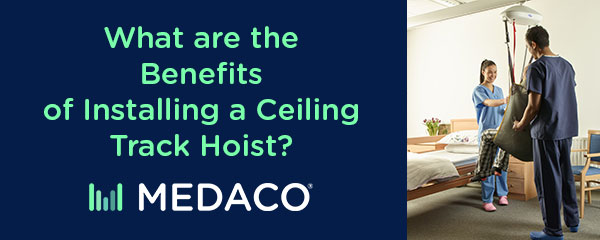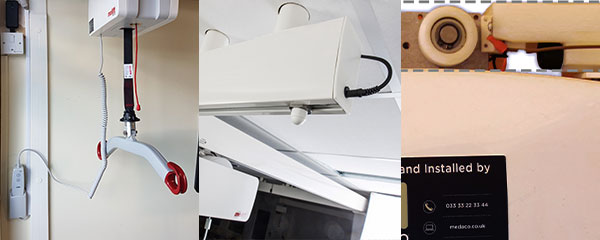Hoist Solutions for Trampolines in SEND Schools
15 Minute Read
Are you aware of the different hoist solutions for trampolines in SEND schools? This article covers the different hoist options as well as the advantages and disadvantages of each.
Trampolines can be a fun way for students to blow off steam at school and can offer a therapeutic way to exercise, for those with physical and learning difficulties.
The official Rebound Therapy federation promotes the use of trampolines to provide opportunities for enhanced movement patterns, therapeutic positioning, exercise and recreation for a wide range of users with additional needs.
But how do these users with additional needs access trampolines in their schools when they are unable to move by themselves?
Moving and handling equipment such as lifting hoists are a great solution for this but finding the right one to fit the needs of your students, care staff and the environment can be a challenge.
Let’s dive into the different hoist solutions available for trampolines in SEND Schools.
Overhead Hoist Solutions for Trampolines
Fixed Ceiling Hoist for Trampolines
A fixed ceiling hoist is a motorised unit that is fitted to a track or rail, which is usually fitted to the ceiling or walls. Ceiling hoist track layouts can vary in design from straight rails to more complex systems such as H frames (also called XY systems) which cover the whole room. They can accommodate a wide variety of care needs and environments.
Fixed ceiling hoists can be installed in a school hall or gymnasium to allow students greater access to trampoline equipment.

Advantages
- The biggest advantage of an overhead hoist is that students can be hoisted directly to the centre of the trampoline in one smooth transfer
- No floor space used or required
- Ceiling hoists can lift from the floor or a lower surface such as a wheelchair, and can also lift as high as required to get onto the trampoline
- With an H system, you can achieve full coverage over the entire room for other lifting needs
Disadvantages
- In school halls where the ceiling is very high – ceiling hoists can be a challenge to install:
- Due to the requirements of ceiling hoists, if you were to fix to a high ceiling, you might need an extensive amount of support frames and metal braces to keep the ceiling hoist sturdy. This would all be visible, so not aesthetically pleasing and it can disturb the open space feel of the hall
- You will also need to have accessory extensions such as extended lift tapes or handsets, to compensate for the large height difference between the hoist rail and the floor
- With a straight rail ceiling hoist layout, the trampoline will need to be positioned directly underneath. This can be a risk for staff and users colliding with the rail when bouncing if the rail cannot be installed high enough
- The lead times for the installation of fixed ceiling hoists can be longer than some of the other options. i.e. they can usually only be installed during the school holidays
Gantry Hoist for Trampolines
An alternative to a fixed ceiling-mounted hoist is the gantry overhead hoist system. Gantry hoist systems provide the benefits of a ceiling hoist without a permanent installation.
Similar to a ceiling hoist, a hoist motor fixes to an overhead rail but the overhead rail is fitted to free-standing upright side posts which can be moved on wheels (when a transfer isn’t in progress).

Advantages
- Students can be hoisted directly to the centre of the trampoline in one smooth transfer
- A versatile piece of equipment that doesn’t need any fixture to the fabric of the building
- The gantry comes in a variety of widths, from 2 to 6 metres. This is the length of the rail the hoist can traverse along
- Some gantry hoists also have a telescopic adjustment at either end, so you can adjust it to make the upright posts as close to the edge of the room as possible, to reduce obstructions
- The height of the gantry upright side posts can also be adjusted in small increments, to suit your changing needs and environment
- Once the student is transferred onto the trampoline, the freestanding gantry can simply be moved or rolled out of the way, to give unhindered access above the trampoline for staff and users
- The gantry hoist is fully mobile, and therefore can be used in other areas of the school, providing doorways are of suitable widths. It can even be used outside in playground areas, as long as the ground is level and smooth
- All the adjustments to the gantry discussed in the above points can be done by your staff, such as the maintenance teams. No tools are required and a LOLER inspection is not required when this equipment is transferred to a different location in the school
- The lead time to have a gantry hoist installed and set up is considerably shorter than a fixed system
Disadvantages
- Storage can be an issue in smaller schools: When the gantry system is not in use, it can be wheeled out the way, however, the feet which span 1240mm, can get in the way in smaller school halls.
Typically we see this overcome by the gantry hoist being stored in the corner of the hall, with chairs or tables stored underneath. This also helps to remove the temptation for students to play or swing on the hoist!
Mobile Hoist for Trampolines
Mobile hoist solutions are suitable for trampolines that are low to the ground, so we have recommended a couple of options for this.
Oxford Presence
The Oxford Presence is a heavy-duty mobile lifting hoist with a substantial lifting range and reach. This mobile hoist can be used in SEND schools when a mobile hoist solution is needed for a trampoline.
Advantages:
- Lifting range from 440mm to 1910mm (suitable for trampolines which are low to the floor)
- No installation and minimal set up required
- Lead times on a mobile hoist are very quick
- Can be transported between rooms and stored when not in use
Disadvantages
- Students can’t be hoisted directly into the centre of the trampoline. They would need to be hoisted to the side of the trampoline and then transferred into the middle with slide sheets etc.
- Does not lift as high as a ceiling hoist so may not reach onto your Trampoline – Check your trampoline height, as they do vary
Victor 2600
The Victor 2600 is a versatile mobile hoist with a good lifting range. Another choice for schools who wish to use a mobile hoist for their trampolines.
Advantages:
- Lifting range from 440mm to 2240mm (suitable for trampolines which are low to the floor)
- No installation and minimal set up required
- Lead times on a mobile hoist are very quick
- Can be transported between rooms and stored when not in use
Disadvantages
- Students can’t be hoisted directly into the centre of the trampoline. They would need to be hoisted to the side of the trampoline and then transferred into the middle with slide sheets etc.
- Does not lift as high as a ceiling hoist so may not reach onto your Trampoline – Check your trampoline height, as they do vary
Benefits of Using an Overhead Hoist for Hoisting onto a Trampoline
The type of hoist you choose will depend on your requirements and the height of your trampoline. At Medaco we would recommend an overhead hoist solution over a mobile hoist based on the following benefits.
Ease of use:
Overhead hoists can provide an easy way of transferring students straight from their wheelchairs to the trampoline and off again, without them getting agitated.
Without the right hoisting solution – schools might need to use a mobile hoist to transfer the student from their wheelchair onto the side of the trampoline and then slide them into the middle with slide sheets or other equipment.
With an overhead hoist, the student can feel more relaxed with one smooth transfer from their wheelchair to the middle of the trampoline. This also saves time during the transfer, which enables the students to have more time on the trampoline.
Safe for care staff:
Furthermore, using an overhead hoist can reduce manual handling related injuries to care staff, particularly on their back. The hoist can be used to lift the student from their wheelchair, they can then lower the student onto the middle of the trampoline in one transfer, without staff putting pressure on themselves or getting into injury-prone positions.
As you can see there are pros and cons of different hoist solutions for trampolines in schools. To make sure you choose the right solution, consider the needs of your students, care staff and the environment it will be used in, both for the short and long term.
Can the solution be adapted or flexible, should your needs change?
If you’re looking for a safe and easy solution for hoisting students onto a trampoline, get in touch with Medaco. We can offer advice and guidance on the different solutions available through a free survey and site visit.




